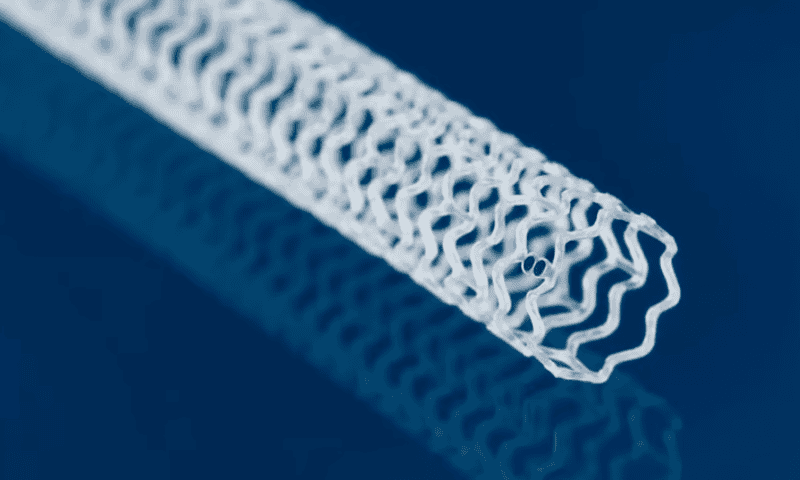Abbott has returned to the field of bio-absorbable, dissolving stents, and in somewhat uncharted territory. The company received a groundbreaking FDA approval for its latest drug-eluting scaffold, designed to help reopen arteries in the legs that have become clogged below the knee.
The Esprit BTK System aims to treat the most severe form of peripheral artery disease, a condition known as chronic limb-threatening ischemia, or CLTI, where hampered blood flow can lead to foot or lower leg amputations.
Until now, the standard of care has been a single-shot balloon angioplasty procedure to clear a path through the small and twisting arteries that are found from the knee on down—previously there had been no stents or drug-coated balloons approved by the FDA to help the vessels stay open over time.
“Various other devices have failed to demonstrate improved outcomes due to the complex and aggressive nature of the disease as well as difficulty keeping arteries open in both the short- and long-term,” the divisional vice president of R&D for Abbott’s vascular business, Richard Rapoza, said in an interview with Fierce Medtech—adding that after a procedure, vessels frequently become blocked again and require additional treatment.
In addition to holding open a path through the artery, the Esprit BTK slowly releases a dose of the immunosuppressive drug everolimus to help prevent the vessel from renarrowing. Made out of a material similar to dissolving sutures, the stent is completely absorbed by the body in about three years.
Abbott previously developed a dissolving, everolimus-eluting stent for reopening clogged coronary arteries in the heart. Named Absorb, the implant claimed an FDA approval in 2016—however, the first-generation device was taken off the market about a year later following slow sales, and amid three-year study results that showed a higher rate of clotting and target vessel myocardial infarction compared to drug-eluting metal stents.
“Esprit BTK System is truly the next generation of resorbable scaffolds,” said Rapoza, citing thinner struts and a different stent pattern for greater performance while employing the same materials as Absorb for its backbone, coating and drug. The offering also sports a redesigned portfolio of accessories and delivery hardware, alongside a procedural training program.
“Two large areas of knowledge developed by Abbott have contributed to this product,” he said. “First is the meticulous control of drug elution from an implant to modulate tissue reactions and improve long term outcomes. Second is the ability to provide temporary vessel support equivalent to that of metallic stent structures using a resorbable polymer. Additionally, the extensive clinical experience that we derived from the Coronary Program informed the proper utilization of resorbable technologies in the Cath Lab.”
In a clinical trial presented at the Transcatheter Cardiovascular Therapeutics conference last fall, Abbott’s Esprit BTK scaffold showed that its addition could improve patient outcomes compared to balloon angioplasty alone. The implant reduced the rate of subsequent vessel restenosis by 25.8%—while 74% of treated patients saw no amputations, completely blocked vessels, or the need to redo the procedure within the first year, compared to 44% in the control arm.
“The FDA approval of Abbott’s Esprit BTK System marks a significant milestone in our fight against peripheral artery disease below the knee and should usher in a new era of improved outcomes for people worldwide,” said Sahil Parikh, director of endovascular services at Columbia University Irving Medical Center, and one of the principal investigators of that study, which was also published in the New England Journal of Medicine. Abbott said it is aiming for a CE Mark approval in Europe in 2025.
The use of disappearing, resorbable scaffolds also make retreating the vessel easier in the future, versus a permanent metal implant. At the same time, as the stent dissolves, the healing artery is once again stimulated by the natural movements of the body.
“A good comparison are trees grown indoors versus ones grown outdoors. The indoor tree is not as strong because it hasn’t been exposed to the elements such as wind that make it stronger,” Rapoza said. “This is exactly how we think about arteries below the knee that are impacted by CLTI.”
“Instead of just pushing some plaque to the side and leaving the artery to heal on its own (like the indoor tree), Esprit BTK System provides a structure that supports the artery as it heals while becoming accustomed to the normal stresses that an artery experiences every day from blood flow and heart rhythm (like an outdoor tree).”
In peripheral artery disease, Abbott estimates that the condition as a whole affects more than 20 million people in the U.S., though only 10% of those may have an official diagnosis.
Several large players in the space have recently launched campaigns to raise awareness of the disease, including Philips and Johnson & Johnson, while the latter recently inked a $13.1 billion deal for Shockwave Medical, the maker of acoustic-powered intravascular lithotripsy catheters designed to break through calcified vessels, including below the knee.

